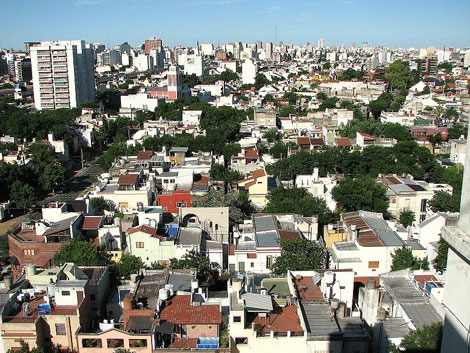
Parque Chacabuco
Parque Chacabuco lies to the southwest of Microcentro and is named after the namesake park that is situated in the heart of the barrio. The barrio shares its borders with Boedo, Caballito, Flores and Nueva Pompeya.
The barrio is made up of a number of sub-barrios which we shall now find out about.
An introduction to Parque Chacabuco
Parque Chacabuco was born out of an area that formed part of the town San Jose de Flores (later to become Flores). The barrio was built around the old Fabrica Nacional de Polvora, a gunpowder factory that was located in the south of the park and was almost entirely destroyed during an explosion on January 26th 1898.
In 1902, the municipality negotiated with the Argentine national government for the transfer of the lands around the factory and upon completion the origins of Parque Chacabuco were formed. At the time, the area was one of both wasteland and estates. As the years passed, the region became populated and progressively developed into the barrio that stands today.
A significant aspect of Parque Chacabuco is the small sub-barrios that exist within its borders. The most prominent is Barrio Cafferatta situated between the streets Estrada, Moreno, Asamblea and Riglos. Introduced in 1921 as a solution to housing issues during WWI, the barrio is characterized by English-style chalets with gardens. Other sub-barrios include Barrio Butteler (1907), Barrio Emilio Mitre (1923) and Barrio Simon Bolivar (1953). They are all part of a group known as ‘barrio obrero’ or ‘barrio de casa baratas’ set up by the government to combat housing problems within the city.
Things to see, do or both
You can probably guess by the name of the barrio; however, if you haven’t worked it out yet, the huge park of Parque Chacabuco is the main reason for coming here. The park was designed by Carlos Thays, a French-Argentine landscaper also responsible for designing Buenos Aires Botanical Garden. It was opened to the public in 1909 and is named after the 1817 Battle of Chacabuco.
The open green spaces and tree lined paths offer a relaxing escape for local residents. There are also two swimming pools, one which is open-air and open during the summer months. Other points of interest within the park are the fountains ‘La Cascada’ and ‘La Cuadrada’, two of the biggest in the city.
Away from the park, Parque Chacabuco is home to a number of active cultural centers. The most notable is Centro Cultural Adan Buenosayres (Asamblea 1200) which has a capacity for 300 guests and focuses on performing arts and alternative theater.
Nightlife and restaurants
Urondo Bar (Beauchef 1204). The aromas from the open kitchen hit you as soon as you set foot in Urondo. A simple yet modern restaurant on a quiet corner, this a true locals hang out. Come on an empty stomach and fill up on scrambled eggs with bacon and mushrooms, shrimp and chickpeas with paprika, and sausages with sauerkraut and mustard. At the weekend you’ll probably find the chefs grilling chorizo and cuts of beef on the street outside.
Pizzeria Scorpio (Cobo 1229). You’ve already seen a hundred places similar to this – the décor resembles your aunt’s kitchen in the 1960s and a compulsory television shows the football – but you can’t go wrong for a value-for-money quick eat. With enough time in the barrio you could attempt to try all of the 50 pizza toppings it claims to have.
Olvidate Bicho (Del Barco Centenera 801). This local parrilla will serve to satisfy all your meat cravings whilst in Parque Chacabuco. Order a la carte or the parrilla libre (carvery or all-you-can-eat). Simple and welcoming, there are a couple of tables available for street side dining.
Why it’s hot / Why it’s not
As it is less popular with tourists and expats, you’ll certainly be able to find some cheaper rents in Parque Chacabuco. Be prepared, however, for a working class neighborhood and nothing like the more Europeanized areas of Palermo.
Furthermore, the southwestern corner of the barrio backs onto Villa 1-11-14, one of the most polemical slums in the city fraught with poverty and drugs. As always in a new city, take the necessary precautions to guarantee your personal safety and if you are not sure, either ask a trusted local or just don’t go.
